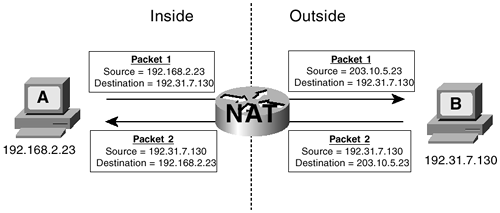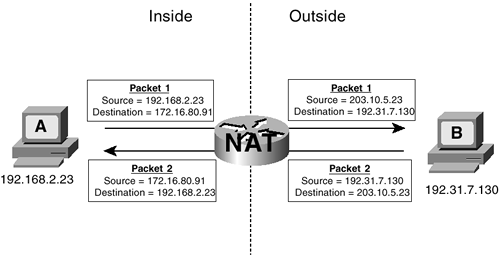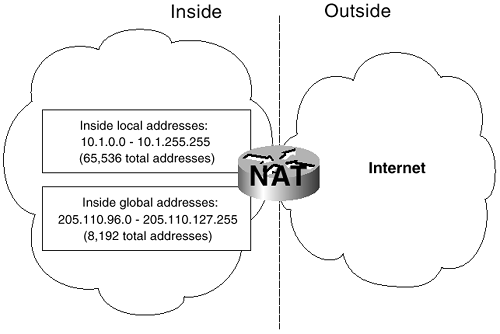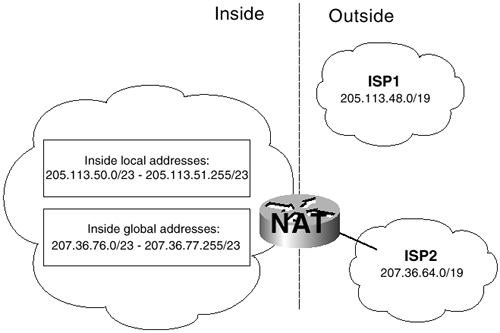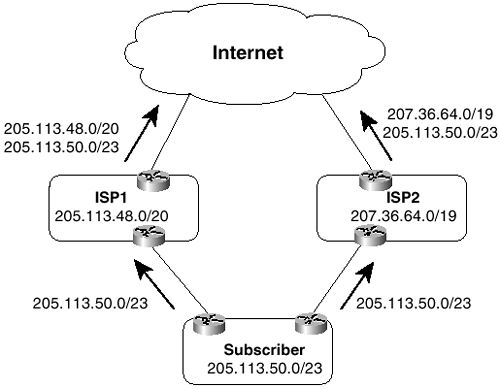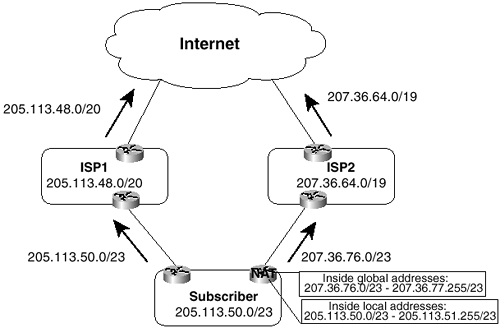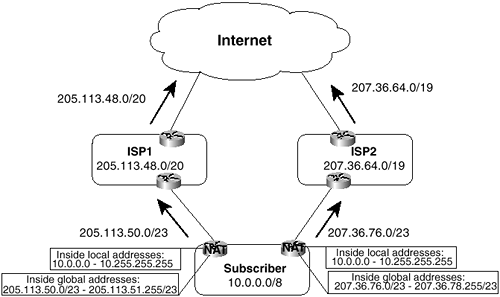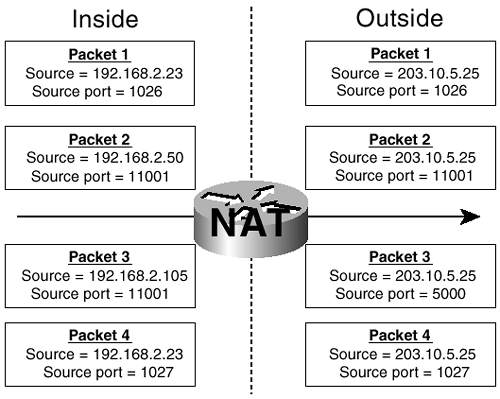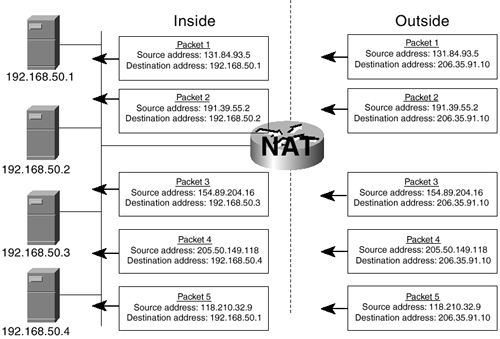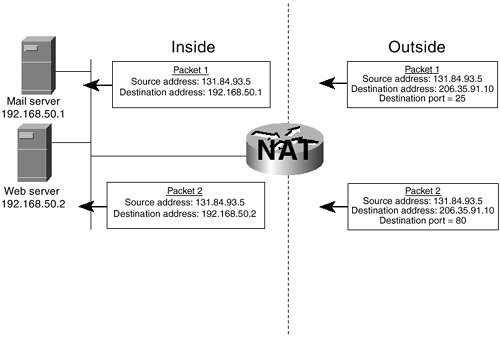Operation of NAT
| NAT is described in RFC 1631.[1] The original intention of NAT was, like classless interdomain routing (CIDR), to slow the depletion of available IP address space by allowing many private IP addresses to be represented by some smaller number of public IP addresses. Since that time, users have found NAT to be a useful tool for network migrations and mergers, server load sharing, and creating "virtual servers." This section examines all these applications, but first describes the basics of NAT functionality and terminology. Basic NAT ConceptsFigure 4-1 depicts a simple NAT function. Device A has an IP address that belongs to the private range specified by RFC 1918, whereas device B has a public IP address. When device A sends a packet to device B, the packet passes through a router that is running NAT. The NAT replaces device A's private address (192.168.2.23) in the source address field with a public address (203.10.5.23) that can be routed across the Internet, and forwards the packet. When device B sends a reply to device A, the destination address of the packet is 203.10.5.23. This packet again passes through the NAT router, and the destination address is replaced with device A's private address. Figure 4-1. The NAT Router Replaces the Private Address of Device A (192.168.2.23) with a Publicly Routable Address (203.10.5.23) NAT is transparent to the end systems involved in the translation. In Figure 4-1, device A knows only that its IP address is 192.168.2.23; it is unaware of the 203.10.5.23 address. Device B, on the other hand, thinks the address of device A is 203.10.5.23; it knows nothing about the 192.168.2.23 address. That address is "hidden" from device B. NAT can hide addresses in both directions. In Figure 4-2, NAT is performed on the addresses of both device A and device B. Device A thinks device B's address is 172.16.80.91, when in fact device B's real address is 192.31.7.130. You can see that the NAT router is translating both the source and destination addresses in both directions to support this address scheme. Figure 4-2. The NAT Router Is Translating Both the Source and Destination Addresses in Both Directions Cisco NAT devices divide their world into the inside and the outside. Typically the inside is a private enterprise or ISP, and the outside is the public Internet or an Internet- facing service provider. Additionally, a Cisco NAT device classifies addresses as either local or global. A local address is an address that is seen by devices on the inside, and a global address is an address that is seen by devices on the outside. Given these four terms, an address may be one of four types:
In Figure 4-2, device A is on the inside and device B is on the outside. 192.168.2.23 is an inside local address, and 203.10.5.23 is an inside global address. 172.16.80.91 is an outside local address, and 192.31.7.130 is an outside global address. IG addresses are mapped to IL addresses, and OL addresses are mapped to OG addresses. The NAT device tracks these mappings in an address translation table. Example 4-1 shows the address translation table for the NAT router in Figure 4-2. This table contains three entries. Reading the entries from the bottom up, the first entry maps OL address 172.16.80.91 to the OG address 192.31.7.130. The next entry maps the IG address 203.10.5.23 to the IL address 192.168.2.23. These two entries are static, created when the router was configured to translate the specified addresses. The last (top) entry maps the inside addresses to the outside addresses. This entry is dynamic and was created when device A first sent a packet to device B. Example 4-1 The Address Translation Table of the NAT Router in Figure 4-2 NATrouter# show ip nat translations Pro Inside global Inside local Outside local Outside global --- 203.10.5.23 192.168.2.23 172.16.80.91 192.31.7.130 --- 203.10.5.23 192.168.2.23 --- --- --- --- --- 172.16.80.91 192.31.7.130 NATrouter# As the preceding paragraph demonstrates , a NAT entry may be static or dynamic. Static entries are one-to-one mappings of local addresses and global addresses. That is, a unique local address is mapped to a unique global address. Dynamic entries may be many-to-one or one-to-many. A many-to-one mapping means that many addresses can be mapped to a single address. In a one-to-many mapping, a single address can be mapped to one of several available addresses. The following sections describe several common applications of NAT and demonstrate more clearly how static NAT and the various implementations of dynamic NAT operate . NAT and IP Address ConservationThe original mission of NAT was to slow the depletion of IP addresses, and this is the focus of RFC 1631. The core assumption of the concept is that only some of an enterprise's hosts will be connected to the Internet at any one time. Some devices (print servers and DHCP servers, for example) never require connectivity outside of the enterprise at all. As a result, the enterprise can be addressed out of the private RFC 1918 address space, and a significantly smaller number of uniquely assigned public addresses are placed in a pool on a NAT at the edge of the enterprise, as demonstrated in Figure 4-3. The non-unique private addresses are IL addresses, and the public addresses are IG addresses. Figure 4-3. In This NAT Design, a Pool of Public IP Addresses Serves a Private Address Space 8 Times as Large When an inside device sends a packet to the Internet, the NAT dynamically selects a public address from the inside global address pool and maps it to the device's inside local address. This mapping is entered into the NAT table. For instance, Example 4-2 shows that three inside devices from the enterprise in Figure 4-3 ”10.1.1.1.20, 10.1.197.64, and 10.1.63.148 ” have sent packets through the NAT. Three addresses from the IG pool ”205.110.96.2, 205.110.96.3, and 205.110.96.1, respectively ”have been mapped to the IL addresses. Example 4-2 Three Addresses from the Inside Local Address Space in Figure 4-3 Have Been Dynamically Mapped to Three Addresses from the Inside Global Address Pool NATrouter# show ip nat translations Pro Inside global Inside local Outside local Outside global --- 205.110.96.2 10.1.1.20 --- --- --- 205.110.96.3 10.1.197.64 --- --- --- 205.110.96.1 10.1.63.148 --- --- NATrouter# The destination address of any packet from an outside device responding to the inside device is the IG address. Therefore, the original mapping must be held in the NAT table for some length of time to ensure that all packets of a particular connection are translated consistently. Holding an entry in the NAT table for some period also reduces subsequent lookups when the same device regularly sends packets to the same or multiple outside destinations. When an entry is first placed into the NAT table, a timer is started; the period of the timer is the translation timeout. Each time the entry is used to translate the source or destination address of a subsequent packet, the timer is reset. If the timer expires , the entry is removed from the NAT table and the dynamically assigned address is returned to the pool. Cisco's default translation timeout is 86,400 seconds (24 hours); you can change this with the command ip nat translation timeout. NOTE The default translation timeout varies according to protocol. Table 4-3, later in this chapter, displays these values. This particular NAT application is a many-to-one application, because for each IG address in the pool, many IL addresses could be mapped to it. In the case of Figure 4-3, an 8-to-1 relationship exists. This is a familiar concept ”telcos use it when they design switches and trunks that can handle only a portion of their total subscribers, and airlines use it when they overbook flights . Think of it as statistically multiplexing IL addresses to IG addresses. The risk, as with telcos and airlines, is in underestimating peak usage periods and running out of capacity. No restrictions apply to the ratio of the size of the local address space and the size of the address pool. In Figure 4-3, the IL range and/or the IG range can be made larger or smaller to fit specific requirements. For example, the IL range 10.0.0.0/8, comprising more than 16 million addresses, can be mapped to a four-address pool of 205.110.96.1 “205.110.96.4 or smaller. The real limitation is not the number of possible addresses in the specified IL range, but the number of actual devices using addresses in the range. If only four devices are using addresses out of the 10.0.0.0/8 range, no more than four addresses are needed in the pool. If there are 500,000 devices on the inside, you need a bigger pool. When an address from the dynamic pool is in the NAT table, it is not available to be mapped to any other address. If all the pool addresses are used up, subsequent inside packets attempting to pass through the NAT router cannot be translated and are dropped. Therefore, it is important to ensure that the NAT pool is large enough, and that the translation timeout is small enough, so that the dynamic address pool never runs dry. Almost all enterprises have some systems, such as mail, Web, and FTP servers, that must be accessible from the outside. The addresses of these systems must remain the same; otherwise outside hosts will not know from one time to the next how to reach them. Therefore, you cannot use dynamic NAT with these systems; their IL addresses must be statically mapped to IG addresses. The IG addresses used for static mapping must not be included in the dynamic address pool; although the IG address is permanently entered into the NAT table, the same address can still be chosen from the dynamic pool, creating an address ambiguity. The NAT technique described in this section can be very useful for scaling a growing enterprise. Rather than repeatedly requesting more address space from the addressing authorities or the ISP, you can move the existing public addresses into the NAT pool and renumber the inside devices from a private address space. Depending on the size of the organization and the structure of its existing address allocations , you can perform the renumbering as a single project or as an incremental migration. NAT and ISP MigrationOne of the drawbacks of CIDR, as discussed in Chapter 2, "Introduction to Border Gateway Protocol 4," is that it can increase the difficulty of changing Internet service providers. If you have been assigned an address block that belongs to ISP1, and you want to change to ISP2, you almost always have to return ISP1's addresses and acquire a new address range from ISP2. This return can mean a painful and costly re-addressing project within your enterprise. TIP It cannot be overemphasized that the pain and expense of an address migration is sharply reduced when the addressing scheme is well designed in the first place. Suppose you are a subscriber of ISP1, which has a CIDR block of 205.113.48.0/20, and the ISP has assigned you an address space of 205.113.50.0/23. You then decide to switch your Internet service to ISP2, which has a CIDR block of 207.36.64.0/19. ISP2 assigns you a new address space of 207.36.76.0/23. Instead of renumbering your inside systems, you can use NAT (see Figure 4-4). The 205.113.50.0/23 address space has been returned to ISP1, but you continue to use this space for the IL addresses. Although the addresses are from the public address space, you can no longer use them to represent your internetwork to the public Internet. You use the 207.36.76.0/23 space from ISP2 as the IG addresses and map (statically or dynamically) the IL addresses to these IG addresses. Figure 4-4. This Enterprise Has an Inside Local Address Space That Belongs to ISP1 But Is a Subscriber of ISP2. It Uses NAT to Translate the IL Addresses to IG Addresses Assigned Out of ISP2's CIDR Block The danger in using a scheme such as this is in the possibility that any of the inside local addresses might be leaked to the public Internet. If this were to happen, the leaked address would conflict with ISP1, which has legal possession of the addresses. If ISP2 is using appropriately paranoid route filtering, such a mistake should not cause leakage to the Internet. As Chapter 2 emphasized , however, you should never make the assumption that an AS-external peer is filtering properly. Therefore, you must take extreme care to ensure that all the IL addresses are translated before packets are allowed into ISP2. Another problem arising from this scheme is that ISP1 will probably reassign the 205.113.50.0/23 range to another customer. That customer is then unreachable to you. Suppose, for example, that a host on your network wants to send a packet to newbie@ISP1.com. DNS translates the address of that destination as 205.113.50.100, so the host uses that address. Unfortunately, that address is interpreted as belonging to your local internet and is either misrouted or is dropped as unreachable. The moral of the story is that the migration scheme described in this section is very useful on a temporary basis, to reduce the complexity of the immediate move. Ultimately, however, you should still re-address your internet with private addresses. NAT and Multihomed Autonomous SystemsAnother shortcoming of CIDR is that multihoming to different service providers becomes more difficult. Figure 4-5 recaps the problem as discussed in Chapter 2. A subscriber is multihomed to ISP1 and ISP2 and has a CIDR block that is a subset of ISP1's block. To establish correct communication with the Internet, both ISP1 and ISP2 must advertise the subscriber's specific address space of 205.113.50.0/23. If ISP2 does not advertise this address, all the subscriber's incoming traffic passes through ISP1. And if ISP2 advertises 205.113.50.0/23, whereas ISP1 advertises only its own CIDR block, all the subscriber's incoming traffic matches the more-specific route and passes through ISP2. This poses several problems: Figure 4-5. Because the Multihomed Subscriber's CIDR Block Is a Subset of ISP1's CIDR Block, Both ISP1 and ISP2 Must Advertise the More-Specific Aggregate
Figure 4-6 shows ways that NAT can help solve the problem of CIDR in a multihomed environment. Translation is configured on the router connecting to ISP2, and the IG address pool is a CIDR block assigned by ISP2. ISP2 no longer advertises an ISP1 address space, so it is no longer necessary for ISP1 to advertise the subscriber's more-specific aggregate. Hosts within the subscriber's enterprise can access the Internet either by selecting the closest edge router or by some established policy. The IL address of the hosts' packets will be the same, no matter which router they pass through; if packets are sent to ISP2, however, the address is translated. So from the perspective of the Internet, the source addresses of packets from the subscriber vary according to which ISP has forwarded the packets. Figure 4-6. NAT Is Used to Resolve the CIDR Problem Depicted in Figure 4-5 Figure 4-7 shows a more efficient design. NAT is implemented on both edge routers and the CIDR blocks from each ISP become the IG address pools of the respective NATs. The IL addresses are from the private 10.0.0.0 address space. This enterprise can change ISPs with relative ease, needing only to reconfigure the IG address pools when the ISP changes. Figure 4-7. The IL Addresses of This Enterprise Have No Relationship to Any ISP; All ISP CIDR Blocks Are Assigned to NAT Inside Global Address Pools Port Address TranslationThe many-to-one applications of NAT discussed so far have involved a statistical multiplexing of a large range of addresses into a smaller pool of addresses. However, there is a one-to-one mapping of individual addresses. When an address from an inside global pool is mapped to an inside local address, for instance, that IG address cannot be mapped to any other address until the first mapping is cleared. However, there is a specialized function of NAT that allows many addresses to be mapped to a single address at the same time. Cisco calls this function port address translation (PAT). The same function is known in other circles as network address and port translation (NAPT) or IP masquerading. It is also sometimes referred to as address overloading. A TCP/IP session is not identified as a packet exchange between two IP addresses, but as an exchange between two IP sockets. A socket is an (address, port) tuple. For example, a Telnet session might consist of a packet exchange between 192.168.5.2, 23 and 172.16.100.6, 1026. PAT translates both the IP address and the port. Packets from different addresses can be translated to a common address, but to different ports of that address, and therefore can share the same address. Figure 4-8 shows how PAT works. Figure 4-8. By Translating Both the IP Address and the Associated Port, PAT Allows Many Hosts to Simultaneously Use a Single Global Address Four packets with inside local addresses arrive at the NAT. Notice that packets 1 and 4 are from the same address but different source ports. Packets 2 and 3 are from different addresses but have the same source port. The source addresses of all four packets are translated to the same inside global address, but the packets remain unique because they each have a different source port. By translating ports, approximately 32,000 different inside local sockets can be translated to a single inside global address. As a result, PAT is a very useful application for small office/home office (SOHO) installations, where several devices might share a single assigned address on a single connection to an ISP. NAT and TCP Load DistributionYou can use NAT to represent multiple, identical servers as having a single address. In Figure 4-9, devices on the outside reach a server at address 206.35.91.10. In actuality, there are four mirrored servers on the inside, and the NAT distributes sessions among them in a round- robin fashion. Notice that the destination addresses of packets 1 through 4, each from a different source, are translated to servers 1 through 4. Packet 5, representing a session from yet another source, is translated to server 1. Figure 4-9. TCP Packets Sent to a Server Farm, Represented by the Single Address 206.35.91.10, Are Translated Round-Robin to the Actual Addresses of the Four Identical Servers Obviously, the accessible contents of the four servers in Figure 4-9 must be identical. A host accessing the server farm might hit server 2 at one time and server 4 another time. It must appear to the host that it has hit the same server on both occasions. This scheme is similar to DNS-based load sharing, in which a single name is resolved round-robin to several IP addresses. The disadvantage of DNS-based load sharing is that when a host receives the name/address resolution, the host caches it. Future sessions are sent to the same address, reducing the effectiveness of the load sharing. NAT-based load sharing performs a translation only when a new TCP connection is opened from the outside, so the sessions are more likely to be distributed evenly. In NAT TCP load balancing, non-TCP packets pass through the NAT untranslated. It is important to note that NAT-based load balancing, like DNS-based load balancing, is not robust. NAT has no way to know when one of the servers goes down, so it continues to translate packets to that address. As a result, a failed or offline server can cause some traffic to the server farm to be black-holed. NAT and Virtual ServersNAT also can allow the distribution of services to different addresses, while giving the appearance that the services are all reachable at one address (see Figure 4-10). Figure 4-10. You Can Configure NAT to Translate Incoming Packets to Different Addresses Based on the Destination Port In Figure 4-10, the enterprise has a mail server at the local address 192.168.50.1 and an HTTP server at the local address 192.168.50.2. Both servers have a global address of 206.35.91.10. When a host from the outside sends a packet to the inside, the NAT examines the destination port in addition to the destination address. In Figure 4-10, a host has sent a packet to 206.35.91.10 with a destination port of 25, indicating mail. The NAT translates this packet's destination address to the mail server's, 192.168.50.1. A second packet from the same host has a destination port of 80, indicating HTTP. The NAT translates this packet's destination address to the Web server's, 192.168.50.2. |
